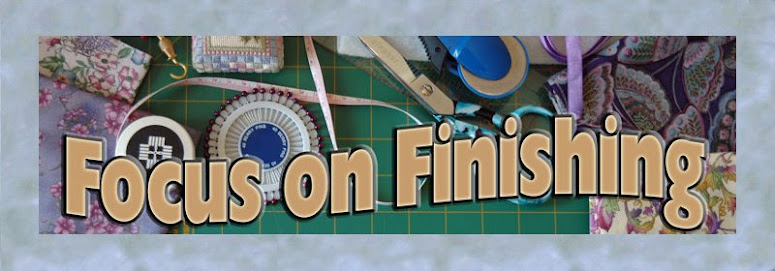- Stitching for the centre of the cushion
- Coordinating fabric(s) for side strips and backing
- Sewing machine with coordinating sewing machine thread to match your fabric(s)
- Scissors/rotary cutter and mat
- Pins
- Ribbon/lace/button embellishments (optional)
- Polyfil stuffing (or something similar)
- Sewing needle and thread to close up the seam opening
1. First of all trim your stitched piece, and cut your coordinating fabric to your preferred length and the approximate width of your sewing project. In my case I have chosen to have my coordinating fabric at the bottom of my stitched piece, and I prefer to have the quilting fabric slightly smaller than my stitched piece so it doesn't take too much attention from the stitching - I have, however, seen some stunning pillows with the stitching taking up just a small amount of room at the top of the pillow. The only difference is down to your preference, as the finishing process is exactly the same.
2. Pin the fabrics together, with right sides facing, and stitch a normal seam allowance (alternatively you may prefer to just a quilters 1/4" seam).
3. At this point I cut off my excess fabrics on each side, and trim my seams to 1/4". This is also the time when you should open up the seam(s) and give a quick pressing with the iron.
4. If you have decided to have fabric on both sides of your stitching (either top and bottom, or left and right) this you will need to repeat the above process a second time for the additional piece of fabric. Once you've finished attaching the coordinating fabrics, check the edges to ensure they're all even, and give it a quick trim with the rotary cutter if needed.
5. At this point I add any seam embellishments to the pillow front. For this particular pillow I just wanted to add one row of matching ric-a-rac. This can either be attached by the sewing machine or by hand (I ended up adding this one by hand, as I didn't have a matching brown sewing machine thread). This is also a good time to add any buttons or other trims you want to add, prior to constructing the pillow itself. Alternatively, you can add your ribbon at the very end once the pillow is finished, but just wrapping it around the pillow and tying a bow to hold it in place :)
6. Now you need to cut your backing fabric the same size as your finished article, and pin them together with right sides facing together (the right side of the stitching will be on the inside of the sandwich).
7. Stitch a seam allowance around the edges, but leave an opening at the bottom so that you can turn your pillow inside-out. I tend to leave about 1 1/2" opening and that's normally enough room to allow for turning.
8. I use a chopstick to help push the corners into a nice shape from the outside - you just have to be careful not to force the seam stitching too much! Once you have turned your pillow inside out, it should look something like this. Now all you have to do is stuff it to your preferred thickness with your favourite stuffing.
9. I close my pillow openings with a ladder stitch - and the following is taken from a previous Christmas ornament tutorial, but is the exact same instruction for closing the pillows.
You need to thread your sewing needle with sewing thread (if you didn't leave a long tail from the seam stitching). You should use a sharp needle here, not a tapestry needle, so that you can pierce the backing fabric easily.
I use a ladder stitch to sew up the opening. As you can see from the left-hand photo below, I start off by slipping my needle into the seam of the backing fabric, then coming back out about 1/4" along the seam (about 3mm) and bring my needle out.
I then take my needle directly opposite where I just came out of the backing fabric and slip my needle into the linen and follow the seam along for about 1/4" (3mm) and bring the needle back out again.
I've left the stitches nice and loose in the photo below to help illustrate how the stitches follow along opposite each other, like rungs of a ladder.

When you pull the thread tighter, the stitches almost disappear into the fabric, giving a really nice clean finish - this is definitely my favourite stitch for closing up openings for that reason!
Once you reach the end of the seam opening, you need to finish off your thread with a couple of teeny stitches - I then bury the needle into the seam and come out somewhere about an inch way and bring the needle back out again - then clip the thread close to the fabric so that my thread tail does't appear easily.
And here's the final seam all finished off - see now nice and tidy that ladder stitch is in the opening? :D
10. And that is the final step in your beautiful new pin pillow coming to life. Now all you need to do is to find somewhere to display it where it can be admired by everyone :D



Following are some additional pillows I have finished in the same way - isn't it amazing how such a simple finishing method can look so different depending on the choice of fabrics and embellishments?
























1 comment:
Anne, you have a wonderful eye for colour! Wonderful project.
Post a Comment